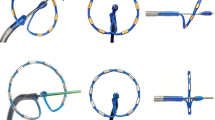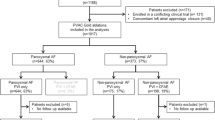Abstract
Purpose
Complete pulmonary vein isolation (PVI) is the best documented target for catheter ablation, and different technologies have shown comparable outcomes. The multielectrode phased-RF/duty cycled (PhRF/DC) pulmonary vein ablation catheter (PVAC) and its second generation (PVAC-GOLD) have shown promising clinical results in single and multicenter experiences. Our aim is to assess and compare the safety and efficacy in the real clinical practice among two generations of circular PhRF/DC catheters by performing PVI in patients suffering from recurrent atrial fibrillation (AF).
Methods
Eighty-four AF patients treated with PVAC and 64 with PVAC-GOLD were prospectively followed in five Italian cardiology centers in the mainframe of the 1STOP-ClinicalService project.
Results
Fluoroscopic and total procedure time were significantly different in the two groups. In particular, in the PVAC-GOLD group, the mean fluoroscopic time was 22.8 ± 12.7 min vs 31.6 ± 18.9 in the PVAC group (p = 0.002), and the mean total procedure duration was 117.6 ± 36.0 vs 147.4 ± 40.6, in the PVAC-GOLD group and the PVAC group, respectively (p = 0.001). Only two out of 148 patients reported a peri-procedural complication. Over 20.9 ± 12.0 months of follow-up, AF recurrence occurred in 58 patients. Kaplan-Meier freedom from AF recurrence did not differ between the two groups (64.1 ± 10% in the PVAC group vs 68.2 ± 9% in the PVAC-GOLD group at 1 year, p = ns).
Conclusions
In our multicenter analysis, AF ablation using two generations of circular PhRF/DC catheters is safe and effective. No difference was observed in terms of safety and efficacy of the AF ablation between the two catheters, with the mean procedural time being shorter in the PVAC-GOLD group.

Similar content being viewed by others
References
Calkins H, Kuck KH, Cappato R, Brugada J, Camm AJ, Chen SA, et al. Heart Rhythm Society Task Force on Catheter and Surgical Ablation of Atrial Fibrillation. 2012 HRS/EHRA/ECAS expert consensus statement on catheter and surgical ablation of atrial fibrillation: recommendations for patient selection, procedural techniques, patient management and followup, definitions, endpoints, and research trial design: A report of the Heart Rhythm Society (HRS) Task Force on Catheter and Surgical Ablation of Atrial Fibrillation. Developed in partnership with the European Heart Rhythm Association (EHRA), a registered branch of the European Society of Cardiology (ESC) and the European Cardiac Arrhythmia Society (ECAS); and in collaboration with the American College of Cardiology (ACC), American Heart Association (AHA), the Asia Pacific Heart Rhythm Society (APHRS), and the Society of Thoracic Surgeons (STS). Endorsed by the governing bodies of the American College of Cardiology Foundation, the American Heart Association, the European Cardiac Arrhythmia Society, the European Heart Rhythm Association, the Society of Thoracic Surgeons, the Asia Pacific Heart Rhythm Society, and the Heart Rhythm Society. Heart Rhythm. 2012;9:632–696.e21.
Cappato R, Calkins H, Chen SA, Davies W, Iesaka Y, Kalman J, et al. Worldwide survey on the methods, efficacy and safety of catheter ablation for human atrial fibrillation. Circulation. 2005;111:1100–5.
Kirchhof P, Benussi S, Kotecha D, Ahlsson A, Atar D, Casadei B, et al. ESC guidelines for the management of atrial fibrillation developed in collaboration with EACTS. Eur Heart J. 2016; https://doi.org/10.1093/eurheartj/ehw210.
Haïssaguerre M, Jaïs P, Shah DC, Takahashi A, Hocini M, Quiniou G, et al. Spontaneous initiation of atrial fibrillation by ectopic beats originating in the pulmonary veins. N Engl J Med. 1998;339:659–66.
Mönnig G, Eckardt L. Multielectrode Pulmonary Vein Ablation Catheter (PVAC®). Current data on results and risks. Herzschrittmacherther Elektrophysiol. 2014;25(4):236–40.
De Greef Y, Buysschaert I, Schwagten B, Stockman D, Tavernier R, Duytschaever M. Duty-cycled multi-electrode radiofrequency vs. conventional irrigated point-by-point radiofrequency ablation for recurrent atrial fibrillation, comparative 3-year data. Europace. 2014;16(6):820–5.
Gal P, Aarntzen AE, Smit JJ, Adiyaman A, Misier AR, Delnoy PP, et al. Conventional radiofrequency catheter ablation compared to multi-electrode ablation for atrial fibrillation. Int J Cardiol. 2014;176(3):891–5.
Nardi S, Argenziano L, Cappato R, de Martino G, Esposito C, Scaglione M, et al. Ablation of paroxysmal and persistent atrial fibrillation with multielectrode phased radiofrequency duty-cycled catheters: long-term results from a large cohort of patients. J Cardiovasc Med (Hagerstown). 2013;14(12):879–85.
Bhatt N, Turakhia M, Fogarty TJ. Cost-effectiveness of cardiac radiosurgery for atrial fibrillation: implications for reducing health care morbidity, utilization, and costs. Cureus. 2016;8(8):e720.
Padeletti L, Curnis A, Tondo C, Lunati M, Porcellini S, Verlato R, et al. Pulmonary vein isolation with the Cryoballoon technique: feasibility, procedural outcomes, and adoption in the real world: data from one shot technologies TO pulmonary vein isolation (1STOP) project. Pacing Clin Electrophysiol. 2016; https://doi.org/10.1111/pace.12975.
De Greef Y, Dekker L, Boersma L, Murray S, Wieczorek M, Spitzer SG, Davidson N, Furniss S, Hocini M, Geller JC, Csanádi Z; PRECISION GOLD investigators. Low rate of asymptomatic cerebral embolism and improved procedural efficiency with the novel PVAC GOLD: results of the PRECISION GOLD trial. Europace 2016;18(5):687–695. https://doi.org/10.1093/europace/euv385.
Deneke T, Shin DI, Balta O, Bünz K, Fassbender F, Mügge A, et al. Postablation asymptomatic cerebral lesions: long-term follow-up using magnetic resonance imaging. Heart Rhythm. 2011;8(11):1705–11.
Lau M, Hu B, Werneth R, Sherman M, Oral H, Morady F, et al. A theoretical and experimental analysis of radiofrequency ablation with a multielectrode, phased, duty-cycled system. Pacing Clin Electrophysiol. 2010;33(9):1089–100.
Fredersdorf S, Weber S, Jilek C, Heinicke N, von Bary C, Jungbauer C, et al. Safe and rapid isolation of pulmonary veins using a novel circular ablation catheter and duty-cycled RF generator. J Cardiovasc Electrophysiol. 2009;20:1097–101.
von Bary C, Weber S, Dornia C, Eissnert C, Fellner C, Latzin P, et al. Evaluation of pulmonary vein stenosis after pulmonary vein isolation using a novel circular mapping and ablation catheter (PVAC). Circ Arrhythm Electrophysiol. 2011;4(5):630–6.
Weber S, Höher M, Schultes D. First results and follow-up of a second-generation circular mapping and ablation catheter. J Interv Card Electrophysiol. 2016;47(2):213–9.
Leitz P, Güner F, Wasmer K, Foraita P, Pott C, Dechering DG, et al. Data on procedural handling and complications of pulmonary vein isolation using the pulmonary vein ablation catheter GOLD. Europace. 2016;18:696–701.
Haines DE, Stewart MT, Dahlberg S, Barka ND, Condie C, Fiedler GR, et al. Microembolism and catheter ablation I: a comparison of irrigated radiofrequency and multielectrode phased radiofrequency catheter ablation of pulmonary vein ostia. Circ Arrhythm Electrophysiol. 2013;6:16–22.
Scharf C, Boersma L, Davies W, Kanagaratnam P, Peters NS, Paul V, et al. Ablation of persistent AF using multielectrode catheters and duty-cycled radiofrequency energy. J Am Coll Cardiol. 2009;54:1450–6.
Gaita F, Leclercq JF, Schumacher B, Scaglione M, Toso E, Halimi F, et al. Incidence of silent cerebral thromboembolic lesions after atrial fibrillation ablation may change according to technology used: comparison of irrigated radiofrequency, multipolar nonirrigated catheter and cryoballoon. J Cardiovasc Electrophysiol. 22:961–8.
Herrera Siklody C, Deneke T, Hocini M, Lehrmann H, Shin DI, Miyazaki S, et al. Incidence of asymptomatic intracranial embolic events after pulmonary vein isolation: comparison of different atrial fibrillation ablation technologies in a multicenter study. J Am Coll Cardiol. 2011;58:681–8.
Mönnig G, Eckardt L. Multielectrode Pulmonary Vein Ablation Catheter (PVAC®). Herzschrittmacherther Elektrophysiol. 2014;25:236–40.
Zellerhoff S, Ritter MA, Kochhauser S, Dittrich R, Kobe J, Milberg P, et al. Modified phased radiofrequency ablation of atrial fibrillation reduces the number of cerebral microembolic signals. Europace. 2014;16:341–6.
Wieczorek M, Hoeltgen R, Brueck M. Does the number of simultaneously activated electrodes during phased RF multielectrode ablation of atrial fibrillation influence the incidence of silent cerebral microembolism? Heart Rhythm. 2013;10:953–9.
Verma A, Debruyne P, Nardi S, Deneke T, DeGreef Y, Spitzer S, et al. ERACE investigators. Evaluation and reduction of asymptomatic cerebral embolism in ablation of atrial fibrillation, but high prevalence of chronic silent infarction, results of the evaluation of reduction of asymptomatic cerebral embolism trial. Circ Arrhythm Electrophysiol. 2013;6(5):835–42.
Spitzer SG, Leitz P, Langbein A, Karolyi L, Scharfe F, Weinmann T, et al. Circumferential pulmonary vein isolation with second-generation multipolar catheter in patients with paroxysmal or persistent atrial fibrillation: Procedural and one-year follow-up results. Int J Cardiol. 2017; https://doi.org/10.1016/j.ijcard.2017.04.035.
Bulava A, Hanis J, Sitek D, Osmera O, Karpianus D, Snorek M, et al. Catheter ablation for paroxysmal atrial fibrillation: a randomized comparison between multielectrode catheter and point-by-point ablation. Pacing Clin Electrophysiol. 2010;33:1039–46.
Bittner A, Monnig G, Zellerhoff S, Pott C, Köbe J, Dechering D, et al. Randomized study comparing duty-cycled bipolar and unipolar radiofrequency with point-by-point ablation in pulmonary vein isolation. Heart Rhythm. 2011;8:1383–90.
Lepillier A, Copie X, Lascault G, Paziaud O, Piot O. A 5-year clinical follow-up after duty-cycled phased RF ablation of paroxysmal atrial fibrillation. J Interv Card Electrophysiol 2016;48(3):327–31.
Pecha S, Aydin MA, Ahmadzade T, Hartel F, Hoffmann B, Steven D, et al. Implantable loop recorder monitoring after concomitant surgical ablation for atrial fibrillation (AF): insights from more than 200 continuously monitored patients. Heart Vessel. 2016;31(8):1347–53.
Charitos EI, Stierle U, Ziegler PD, Baldewig M, Robinson DR, Sievers HH, et al. A comprehensive evaluation of rhythm monitoring strategies for the detection of atrial fibrillation recurrence: insights from 647 continuously monitored patients and implications for monitoring after therapeutic interventions. Circulation. 2012;126(7):806–14.
Brachmann J, Morillo CA, Sanna T, Di Lazzaro V, Diener HC, Bernstein RA, et al. Uncovering Atrial Fibrillation Beyond Short-Term Monitoring in Cryptogenic Stroke Patients: Three-Year Results From the Cryptogenic Stroke and Underlying Atrial Fibrillation Trial. Circ Arrhythm Electrophysiol. 2016;9(1):e003333. https://doi.org/10.1161/CIRCEP.115.003333.
Goldenberg GR, Burd D, Lodzinski P, Stabile G, Udell JA, Newman D, et al. Antiarrhythmic therapy as an adjuvant to promote post pulmonary vein isolation success, a meta-analysis. J Interv Card Electrophysiol. 2016;47:171–6.
Author information
Authors and Affiliations
Corresponding author
Ethics declarations
Compliance with ethical standards
The project was approved by each site’s Medical Ethics Committee or Medical Director and conforms to the principles outlined in the Declaration of Helsinki. Each patient provided informed consent for data collection and analysis.
Competing interests
The authors declare that they have no conflicts of interest.
Funding
This research was performed within the framework of the Italian ClinicalService, a project funded by Medtronic Italia, an affiliate of Medtronic Inc. No other funding sources were involved in the research.
Additional information
Rights and permissions
About this article
Cite this article
Rovaris, G., De Filippo, P., Laurenzi, F. et al. Clinical outcomes of AF patients treated with the first and second-generation of circular mapping and ablation catheter: insights from a real world multicenter experience. J Interv Card Electrophysiol 50, 245–251 (2017). https://doi.org/10.1007/s10840-017-0278-y
Received:
Accepted:
Published:
Issue Date:
DOI: https://doi.org/10.1007/s10840-017-0278-y




